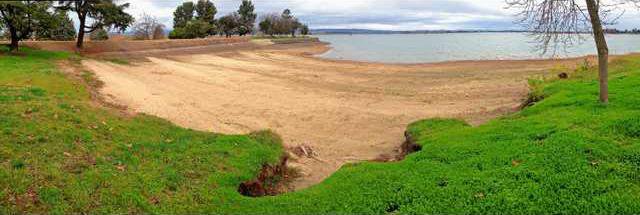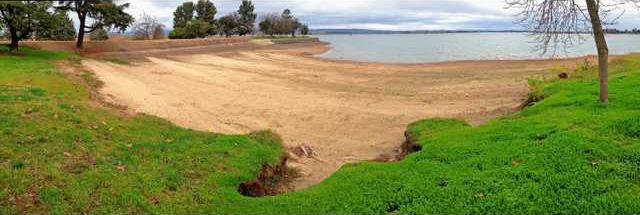The completion of Woodward Reservoir a century ago this year has been a godsend to South San Joaquin Irrigation District as well as the cities of Manteca, Lathrop, and Tracy.
It has played a key role as an in-district safety net to help SSJID to weather the drought in much better shape than many other water purveyors in California including Tri-Dam Project partner, the Oakdale Irrigation District.
The reservoir that holds 36,000 acre feet of water or enough for just over three complete districtwide irrigation runs is off stream as opposed to Tri-Dam reservoirs at Goodwin, Tulloch, Beardsley, and Donnells as well as the Bureau of Reclamation’s New Melones that holds up to 600,000 acre feet for OID and SSJID as the result of the original Melones Reservoir being inundated to build it.
That means when the Bureau shuts off water movement to irrigation districts from the Stanislaus River watershed every year on Sept. 30, SSJID has a stash of water if needed for a late fall run and to help supply drinking water to Manteca, Lathrop, and Tracy until March when diversions start again.
It helped to keep domestic water costs lower in Manteca as the district did not need to build a 20,000-acre-foot storage reservoir to supply the Nick DeGroot South San Joaquin County Water Treatment Plant when it was built in the last decade.
While the reservoir located in eastern Stanislaus County on 26 Mile Road accessed via Highway 120 or Dodds Road is primarily a lake built to hold irrigation water, it does double duty as a major recreation spot. The district leases 3,767 acres surrounding the reservoir to Stanislaus County. It is that county’s top revenue producing park.
If Woodward Reservoir hadn’t been built, there district last year would have had to either reduce water deliveries to farmers and cities by more than the 20 percent they did or would have had to forgo at least one if not two irrigation runs. It also serves as a cushion in the advent rock slides or other issues disrupt diversion deliveries from Goodwin Dam
Pioneer Walter J. Woodward — for whom Woodward Reservoir is named — was responsible for the ground work for securing water that made it possible for Manteca to grow from a railroad siding to a vibrant agriculture commerce center in the late 1910s.
He was part of the five original SSJID directors — the others were C.M. Carlson, Fred H. Kincaid, B.A. Goodwin, and C.T. Wiggin — elected at the same time a $1,875,000 bond issue was approved on a 396 to 67 vote on May 11, 1909.
SSJID joined forces with OID to construct the 400-foot Goodwin Dam on the Stanislaus River upstream from Knights Ferry. It was completed in December 1912. Its dedication on April 6, 1913 featured Gov. Hiram Johnson opening the head gate before addressing more than 4,000 people gathered for the major milestone ceremony.
After the dam was built, almost 300 miles of tunnels, ditches, and flumes were built to deliver water to Manteca farms.
Woodward Reservoir
built at cost
of $600,000
It was Woodward’s suggestion that the reservoir site be selected plus his idea to create a distribution system to reach every 40 acres rather than just larger area ranches.
Woodward served as SSJID director from 1909 to 1916. He spent many hours laying out the system including the reservoir.
The reservoir cost $600,000 when it was completed in 1916. By comparison, the water play feature that was built in Manteca’s Library Park in 2008 for $450,000.
The reservoir is the last holding area for irrigation water before it is diverted into canals for the trip to 60,000 irrigated farm acres in the Ripon, Manteca and Escalon areas.
Almonds are the biggest irrigated crop in the SSJID service territory with 33,000 acres followed by alfalfa at 6,000, grapes at 6,000, pastureland at 5,200, walnuts at 2,400 and peaches at 1,800. The rest is split between a diversity of crops ranging from corn to melons.
The ability to buy land close to irrigation lines triggered Manteca’s first economic boom helping the city to virtually double in size overnight.
Woodward was born Aug. 2, 1858 in Wolcott, Vermont. At age 14 he moved with his family to farm near Greely, Co., where he learned Morse Code. That enabled him able to land his first job away from the family farm as the railroad’s station agent at Greely.
Invented way to
machine band
Wooden pipe
Eventually he owned the second largest hardware store in Denver but lost it during the Panic of 1893. He was able to pay his debts and moved his family to National City in Southern California in 1893. It was there, relying on his experience helping dig irrigation ditches on his father’s farm that Woodward invented a way to machine band wood pipe. In 1897 he filed for a patent and joined with partners to form the California Redwood Pipe Co. They soon were filling orders throughout the West and eventually merged with the National Wood Pipe Co. He was made vice president and moved his family to Oakland across the bay from the firm’s headquarters in San Francisco.
A heart problem prompted him to leave the company in 1905. It was that year he purchased 160 acres on the north side of what is now Woodward Avenue at the intersection with Oleander Avenue.
The ranch was successful under pump irrigation but he realized how much more productive the entire area could be with surface irrigation and set about working with others to form the SSJID.
He became Manteca’s first real estate agent in 1907.
The Manteca Unified School District named Walter Woodward School south of Woodward Park in his honor as are Woodward Park and Woodward Avenue..
To contact Dennis Wyatt, email dwyatt@mantecabulletin.com





